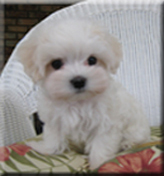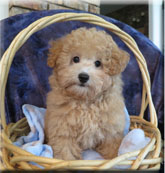
Toy Puppies Presents: 'Puppy-Dog Tales'
Training
Hi Everyone,
Happy 2000! I hope this will be a great year for all of you!
Yesterday, on the cable Discovery channel, I was watching a documentary about dogs and their behavior. I have studied the subject for years, however, I found several tidbits of information I was not aware of. Learning is a lifelong endeavor. I find I sometimes get impatient with the people, and we all know some, who think they know it all. No one ever knows it all!
I have always been eager to spout information on the fine art of housebreaking a puppy. For the last 18 years at any given time I am training one, two or even three puppies or young adolescents. I have discovered something recently that made me stop and think about what I have been telling people. Don't get me wrong; my methods are tried and true and work most of the time. The dogs, however, have individual personalities and can react to the same training very differently. The owners, or those trying to train the dog, in most cases do not have the years of experience that would tell them if their particular dog is reacting normally. The result in most cases is catastrophic. The dog doesn't get trained and the people get frustrated, impatient and often angry. The rest is predictable; they label the dog incorrigible and get rid of it. Now the dog is older, still not trained, and further confused by being shuffled into a new home. This is if the dog is fortunate enough to be born an expensive purebred, the alternative is the pound and you know what that means.
The books and trainers seem to lump all dogs together. A dog, is a dog, is a dog; train it this way. NOT true!!! I have trained Dobermans, Yorkies, Dalmatians, Bichons, Chihuahuas and Shih-Tzus, and I will tell you they are all DIFFERENT!
Most of the toys are companion dogs not working dogs. What does that mean? They do not have as much desire to take commands and follow orders. They were bred to be a friend not an employee. A working breed must perform tasks to be in good favor with its owner, most companion dogs need only wag their tail and give good puppy kisses. Are you beginning to see my point? A Labrador puppy weighs about 10 pounds at 12 weeks. The average person would not hesitate to grab him by the scruff of the neck and give him a potch on his butt while yelling "NOOO, Bad Dog!!" for making a BM in the middle of the kitchen. He is than tossed outside to think about what he did. Now visualize a tiny Maltese or Yorkie in the same situation... At 12 weeks, most of these breeds are 2½ to 3 lbs. and make what looks like a Tootsie Roll. Is the reaction the same as the Lab got?? No, not often. The owner will look at him and say "Oh honey, that's a no-no mommy doesn't like when Poopsie makes on the floor." Does the dog think you are really mad? No, not often. Will he learn from this experience?? No, not often.
Even if you did everything right, it still takes much longer to train a companion dog than a working breed. Let us come back to the problem of dealing with the individual puppy. He has a personality all his own. Some dogs are more sensitive than others (some people are more sensitive than others). The secret is to carefully observe the reactions your dog has to various situations to determine what temperament you are dealing with so you can train accordingly. For instance, you are playing with your puppy and he nips your finger; if you yell at him and wave a finger at him does he: A) back away, put his ears down and slink to the floor? B) wag his tail and jump to grab at your finger or C) stand his ground, cock his head to the side and look you in the face? None of these answers are wrong; they are simply different personalities. You, as the trainer, must be able to interpret these reactions and react appropriately. Unfortunately, most people don't know the correct way to deal with these three different personalities so they do what the book says and in only one out of three cases it is the right choice.
So, what do you do? Read several books on dog behavior as well as training. Speak to friends and relatives who have had many dogs; especially take note of what kind of dogs they are. Speak to your breeder about any special problems. Above all, be patient. A puppy is like a baby, they have a short attention span and must be reminded constantly. Don't have unrealistic expectations. A human child is expected to be more intelligent than a dog, however, babies would make in their pants all their life if mom didn't spend a year toilet training them. A puppy can wait to go out one hour for every month old it is. Think about that; a 3-month-old puppy will pee every three hours. Also remember it is not fair to expect a dog to wait 8 to 12 hours while you are at work. If you are gone that long, put down newspaper even for an adult dog.
Here is a concept that most pet owners are not ready to accept. Sometimes the dog you have chosen is just not right for your family. He may be too shy, too aggressive, too independent or more often too dependent. Most people select a breed based mostly on looks. They go through a book and pick out a cute dog never taking into consideration what the breed was originally bred to do. For instance, a lady I know who had several cats decided to get a dog she picked a Dachshund. She thought they looked cute. She never researched what the breed was developed to do. A Dachshund was bred to go on the ground after small rodents and weasels. Long story short; the dog killed two of the cats. He wasn't mean, he was just doing what he was bred to do. Before you buy a dog investigate what the breed was originally developed to do. Is that what you want? If for some reason it isn't working out, don't force yourself to stay in an unhappy relationship. We certainly don't do it in our lives, so why do it with our dog? Find him another home. He may be much happier in a different home and you may be happier with a different dog.Until next time, remember:
Try to be as wonderful as your dog thinks you are.
Warmest Regards,
Myra















